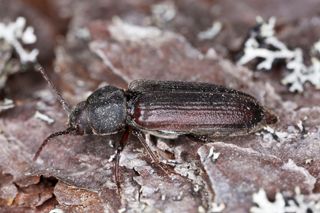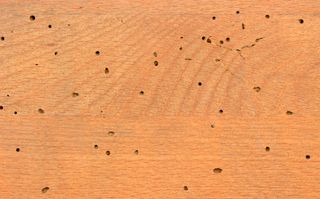If you notice your timber furniture showing weird signs of damage, such as tiny holes randomly located on the surface and dust around or the wooden flooring of your house seems weak, you could be dealing with a borer infestation. This article will help you identify and treat a timber borer infestation. So without further ado, let's get into it.
What are Wood Borers?
Wood borers are a kind of beetle that munch on wood and timber furniture. There are various types of wood borers found all around Australia. While some pose as a threat, others are simply a nuisance to have around.
It all begins when a female borer lays her eggs in/on wood. Soon later, the larvae hatch and start digging holes into the structure. When the larvae mature into an adult, they are ready to leave the item and fly away, leaving behind exit holes in whatever is left of your timber item.
Unfortunately, most owners only learn of their presence after they have matured and caused significant damage.
Difference Between Borers and Termites
 Although both pests have a similar diet, they are different in several aspects. For instance, borers are beetles, and termites are ant-like pests.
Although both pests have a similar diet, they are different in several aspects. For instance, borers are beetles, and termites are ant-like pests.
Borers cause the most damage during the larvae stage and make their nest within the timber furniture in your house. Whereas, termites build their nest elsewhere and return to the infested timber furniture whenever they are hungry.
How to Identify Borers?
-
Common Furniture Beetle:
The most common type of borer found in Australia is the common furniture beetle. It is brown, oval and its size varies between 2.7 to 4.5 mm. After it has matured and is ready to leave the furniture, it creates 1 - 2 mm wide exit holes.
Common furniture beetles prefer softwood such as pine, but as they aren't picky eaters, they could also attack hardwood. Damp locations like wooden flooring and cellars are often susceptible to them.
-
Queensland Pine Beetle:
Native to south-east Queensland, an adult Queensland pine beetle is 1.5 mm wide and 3 mm long. It is oval, hairy and reddish-brown with a glossy exterior. Their legs are firmly folded against their body, and their exit holes are 2 mm wide.
This type of wood-boring pest mainly infests hoop pine sapwood and wooden housing frameworks such as walls, flooring, and furniture. Queensland pine beetles cause significant damage to old houses and timber items as it continues to infest them until it loses strength completely.
-
Powderpost Beetle:
As the name suggests, powderpost beetles have the potential to turn infested wood into powder over time. The size of this adult wood-boring beetle ranges between 3 to 19 mm, while the size of their exit holes is between 0.8 - 3.2 mm. They mainly attack hard and softwood with high starch content. They do not cause drastic structural damage but often attack timber items like flooring, furniture, tools, decorative pieces, etc.
-
European House Borer:
This wood-boring pest is also known as an old house borer or a longhorn beetle. Its size varies between 8 - 20 mm, and when exiting, it leaves behind 6 to 10 mm wide exit holes. This beetle appears grey due to its fur but is either black or brown. Sometimes, their legs and antennae could be reddish. They love to feed on the sapwood of pine, softwood, spruce, and fir.
Although they often attack newer houses due to their love of high resin content, they also attack older houses and the damage done there is far worse than that of newer houses.
-
Lesser Auger Beetle:
Known for being challenging to detect and a huge nuisance to owners, this beetle loves to munch on high starch and sapwood content timber, whether it is a housing structure or a furniture piece. It has a long cylindrical body that is 2 to 3.5 mm wide and 6 to 13 mm long. They have a shiny exterior and are brown-black or reddish-brown.
How to Identify Borer Damage?
 Now that you know how to identify a borer, the next step would be learning how to identify borer damage. Sadly, most of these signs are only noticeable after the larvae have finished damaging your timber items.
Now that you know how to identify a borer, the next step would be learning how to identify borer damage. Sadly, most of these signs are only noticeable after the larvae have finished damaging your timber items.
A Few Common Signs of a Borer Infestation and Damage are:
-
Exit Holes:
If you have a new or ongoing infestation in your home, you will notice freshly made oval or round holes on the surface of the infected furniture.
-
Frass:
Larvae constantly munching on your timber leads to borer dust, also known as frass. However, you would only notice the frass after the beetle has exited, bringing the frass outside with it.
-
Crumbling and Damaged Furniture:
Borer infestations in wooden furniture and housing structures would cause the corners to crumble. Therefore, if you notice your timber furniture crumbling for no reason, you should get a home inspection for a borer infestation.
-
Damaged Floorboards:
If your flooring and wooden floorboards are infested with borers, then it would feel and seem spongy, weak, and damaged.
Some other common yet hard-to-find signs of an infestation are noticing tunnels and finding beetle eggs, larvae, and adult beetles themself.
Treating a Wood Borer Infestation
-
Determine the Type of Infestation:
Proper identification is vital for efficient treatment. The first step is to find out if the infestation is active or not. You can do that by looking out for wood powder near the infected furniture. There may be larvae still present if the powder is white and doesn’t clump together. However, if the powder is clumpy and yellow, it indicates that the larvae have matured and left the infected furniture.
-
Choose the Right Kind of Treatment:
If it is an ongoing infestation, you would need to treat the infected item, and if dealing with adult beetles, you would need to use insecticide. For non-active infestations, you will need to replace the infected item or seal it properly.
If it is your furniture, then you can decide if you want to get rid of it or not. However, infected housing structures should be inspected for severe damage and replaced for the safety of your loved ones.
How Can a Pest Control Specialist Help?
If you are unsure about your finding, the type of species you are dealing with or do not wish to play around with insecticides or other heavy chemicals, it would be best to call an expert. A professional expert has the right knowledge, skills, and experience along with the right equipment and treatment to help eliminate the borer infestation in your home.
In conclusion, wood borers are beetles whose larvae feed on wood. There are various types of borers that infest various kinds of wood. From weakening the structure of your wooden furniture and leaving exit holes to completely turning your wooden furniture into powder, wood borers cause significant damage to your homes.
Therefore, it is essential to eliminate them as soon as possible. With the help of professional experts, you can easily and quickly control and remove these pests from your home.